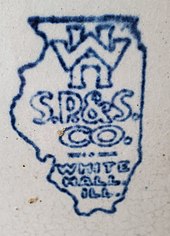|
White Hall, Illinois
White Hall is a city in Greene County, Illinois, United States. The population was 2,295 at the 2020 census.[3] History A post office called White Hall has been in operation since 1827.[4] In 1830 a David Barrow was the first person to build and in a location that would become White Hall. Two years later he bought another 80 acres of land at the price of $200 for the purpose of creating the town. Four years later, in 1836 White Hall was official established.[5] This area was the home to a long, white tavern owned by James Allen, which was the only hotel between Carrollton, Illinois and Jacksonville, Illinois. The town got its name from the fact that when a stage was approaching the tavern, the driver would call out "Next stop, the White Hall."[6] White Hall became known for pottery as ceramics was historically one of the town's top industries. Between 1825 and 1948 White Hall had 39 commercial potteries. One of the earliest was established by John Neff Ebey.[7] Other pottery operations included William Heath, George Ebey, David Brunk, the Davis brothers, David Culbertson, A. D. Ruckel, the Vermillion brothers, William Teter, and the White Hall Sewer Pipe & Stoneware Company.[8] Stoneware from A. D. Ruckel's White Hall Pottery Works and White Hall Sewer Pipe and Stoneware Company remain well known to collectors. GeographyWhite Hall is located at 39°26′22″N 90°23′57″W / 39.43944°N 90.39917°W (39.439466, -90.399248).[9] According to the 2021 census gazetteer files, White Hall has a total area of 2.63 square miles (6.81 km2), of which 2.58 square miles (6.68 km2) (or 97.84%) is land and 0.06 square miles (0.16 km2) (or 2.16%) is water.[10] Climate
Demographics
As of the 2020 census[3] there were 2,295 people, 944 households, and 572 families residing in the city. The population density was 871.30 inhabitants per square mile (336.41/km2). There were 1,081 housing units at an average density of 410.40 per square mile (158.46/km2). The racial makeup of the city was 95.77% White, 0.09% African American, 0.13% Native American, 0.35% Asian, 0.09% Pacific Islander, 0.00% from other races, and 3.57% from two or more races. Hispanic or Latino of any race were 0.70% of the population. There were 944 households, out of which 27.0% had children under the age of 18 living with them, 39.62% were married couples living together, 13.56% had a female householder with no husband present, and 39.41% were non-families. 34.53% of all households were made up of individuals, and 16.95% had someone living alone who was 65 years of age or older. The average household size was 3.17 and the average family size was 2.41. The city's age distribution consisted of 23.8% under the age of 18, 7.7% from 18 to 24, 17.4% from 25 to 44, 32% from 45 to 64, and 19.1% who were 65 years of age or older. The median age was 46.0 years. For every 100 females, there were 89.2 males. For every 100 females age 18 and over, there were 83.8 males. The median income for a household in the city was $42,596, and the median income for a family was $51,250. Males had a median income of $31,762 versus $26,705 for females. The per capita income for the city was $23,208. About 4.7% of families and 11.2% of the population were below the poverty line, including 8.6% of those under age 18 and 4.9% of those age 65 or over. Notable people
References
External links |
||||||||||||||||||||||||||||||||||||||||||||||||||||||||||||||||||||||||||||||||||||||||||||||||||||||||||||||||||||||||||||||||||||||||||||||||||||||||||||||||||||||||||||||||||||||||||||||||||||||||||||||||||||||||||||||||||||||||||||||||||||||||||||||||||||||||||||||||||||||||||||


